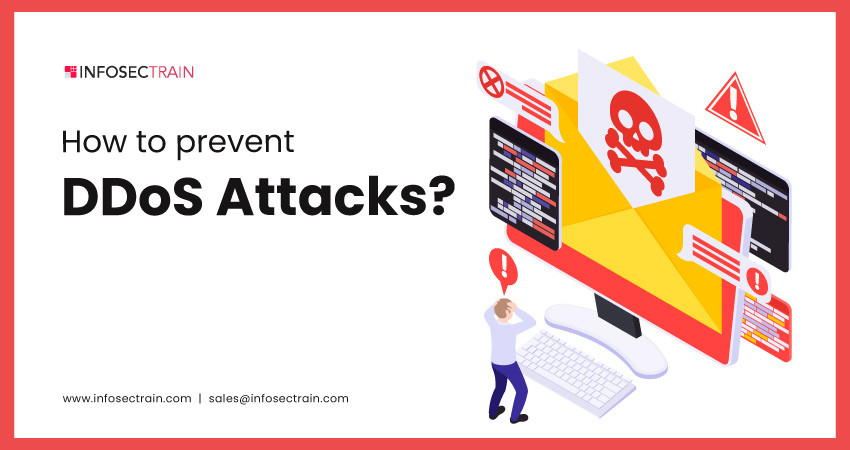How to prevent DDoS attacks?
Over the past year, there has been a significant surge in DDoS attacks, largely attributed to the global pandemic. With a vast number of individuals working remotely and relying heavily on online services through remote connections, the vulnerabilities in digital infrastructure became more apparent. As per the reports, around 10 million DDoS attacks happened against essential online services. The DDoS attacks wreaked havoc on e-commerce, healthcare, streaming services, and remote learning, disrupting business operations and extortion by hackers.

Table of Contents
What is a DDoS attack?
How does a DDoS attack work?
Best practices to prevent DDoS attacks
What is a DDoS attack?
A Distributed Denial-of-Service (DDoS) attack is a malicious attack intended to disrupt the regular traffic of a targeted network, service, or server by flooding the target or its surrounding infrastructure with Internet traffic. It involves multiple connected devices, known as botnets, used to flood target websites with malicious traffic.
How does a DDoS attack work?
DDoS attacks are worked with networks of Internet-connected machines. These networks include systems and other IoT devices infected with malware and controlled remotely by an attacker. The individual devices are known as bots, and a group of bots is called a botnet. If a botnet has been established, the attacker can attack by sending remote instructions to each bot.
When the botnet targets a victim’s network or server, each bot sends requests to the target’s IP address, which potentially causes the server or network to become infected, resulting in a DDoS to regular traffic. As each bot is a legitimate Internet device, splitting the attack traffic from regular traffic can be difficult.
Best practices to prevent DDoS attacks:
Following the best practices and measures can mitigate the potential impacts of a DDoS attack.
1.Create a DDoS response plan
Developing an incident response plan that ensures staff members respond promptly and effectively. This plan should include the following:
- A clear and step-by-step guide on how to respond to a DDoS attack.
- Escalation protocols
- A checklist of all the necessary tools.
- How to maintain business operations.
- Go-to staff members and key stakeholders.
- Team responsibilities.
- A list of mission-critical systems.
2. Continuous monitoring of traffic
Using continuous monitoring (CM) to analyze traffic in real time is the best way to identify DDoS attacks. The following are the benefits of continuous monitoring:
- Real-time monitoring ensures that you identify a DDoS attack before it becomes fully operational.
- Round-the-clock monitoring ensures the identification of DDoS attacks outside of office hours and on weekends.
- A team can establish a good understanding of typical network activity and traffic patterns.
- Depending on the configuration, the continuous monitoring tool either contacts administrators or follows response instructions from a predefined script in the event of an issue.
3. Limit network broadcasting
A hacker behind a DDoS attack will send requests to every device on your network in order to amplify its impact. The security team can counter this tactic by restricting network broadcasting between devices.
4. Ensure high levels of network security
High-level network security is essential for preventing any DDoS attack attempt. Identifying a DDoS early on is vital to controlling the radius. The following types of network security help protect your business from DDoS attempts:
- Firewalls and intrusion detection systems serve as barriers that scan network traffic.
- Endpoint security ensures network endpoints (desktops, laptops, mobile devices, etc.) do not become an entry point for malicious activity.
- Network segmentation divides systems into subnets, each set of security protocols and controls.
- Tools check if the source address matches the origin address to prevent spoofing.
- Web security tools detect and eliminate web-based threats, block abnormal traffic, and look for attack signatures.
5. Identify the signs of a DDoS attack
If your security team can rapidly identify the signs of a DDoS attack, you will be able to take the necessary precautions and limit the damage. Common signs of a DDoS attack include:
- Slow performance
- Poor connectivity
- Crashes
- High demand for a single endpoint
- Unusual traffic from IP addresses
- Spike in traffic from users with a standard profile (geolocation, system model, web browser version, etc.)
A low-volume, short-duration attack often goes unnoticed as a random occurrence, and such attacks can be a test or a distraction for dangerous attacks (such as ransomware). As a result, detecting a low-volume attack is essential.
6. Make use of server redundancy
Using multiple distributed servers makes it difficult for a hacker to attack all servers simultaneously. If an attacker successfully launches a DDoS attack on a single hosting device, other servers remain unaffected and accept additional traffic till the targeted system is restored.
7. Leverage the cloud to prevent DDoS attacks
Cloud-based protection can scale and handle even a major volumetric DDoS attack easily. The use of a third-party vendor for DDoS prevention can have the following key benefits:
- Cloud providers provide well-rounded security with top firewalls and threat monitoring software.
- The public cloud has greater bandwidth than any private network.
- Data centers offer high network redundancy with copies of data, equipment, and systems.
Final words:
DDoS attacks are increasing and becoming more dangerous to mitigate. Even experts predict an increase in DDoS attacks in the upcoming days to 15.4 million by 2023. Implementing the best measures to prevent DDoS attacks in the future is more important to avoid data loss, network interruptions, and disturbances in business operations.
InfosecTrain‘s various cybersecurity training courses provide comprehensive knowledge and practical skills to understand and implement effective DDoS prevention strategies, including network security, traffic monitoring, incident response, and mitigation techniques.




 1800-843-7890 (India)
1800-843-7890 (India) 
